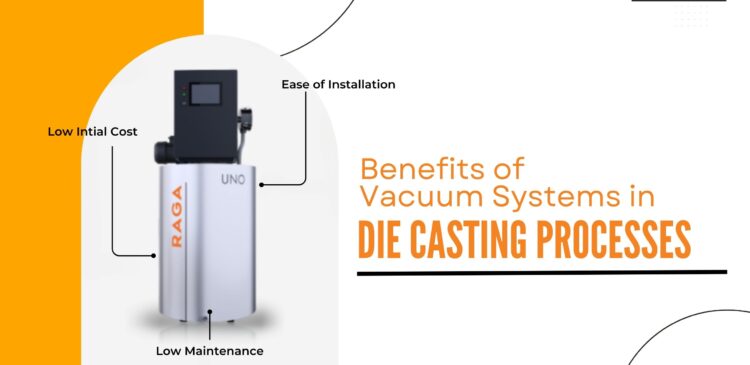Benefits of Vacuum Systems in Die Casting Processes

In today’s fast-paced manufacturing world, precision, efficiency, and quality are paramount. Traditional die casting methods have served industries well for decades, but with rising demands for flawless and high-strength components, vacuum die casting is revolutionizing the game. This innovative technique not only improves product quality but also significantly reduces casting defects and waste.
In this blog, we’ll explore what vacuum die casting is, how it differs from conventional methods, and the numerous benefits it offers to industries like automotive, aerospace, and electronics.
What is Vacuum Die Casting, and Why is it Important?
Vacuum die casting is a process where air is evacuated from the die cavity before the molten metal is injected. This allows for a more complete and dense filling, eliminating air pockets that can lead to porosity and other defects.
Traditional vs. Vacuum-Assisted Die Casting
Traditional die casting traps air in the cavity as molten metal is injected, often causing defects like gas porosity and shrinkage.
Vacuum-assisted die casting uses vacuum pumps to remove air and create a low-pressure environment, ensuring better metal flow, improved component strength, and smoother finishes.
Understanding Vacuum Systems in Die Casting
How Vacuum Technology Works in Casting
Vacuum systems are installed in the die casting machine to remove air from the mould cavity before metal injection. By doing so, the metal fills the mould without turbulence or trapped gases, resulting in high-quality components.
Why Air Removal Matters
Air trapped in molten metal can cause:
– Gas porosity
– Incomplete filling
– Poor surface quality
– Weak mechanical properties
Vacuum technology eliminates these problems by enhancing the fluidity of the metal and ensuring a clean, bubble-free structure.
Standard vs. Vacuum-Assisted Die Casting
| Feature | Traditional Casting | Vacuum Die Casting |
| Air Removal | No | Yes |
| Porosity | High | Low |
| Surface Finish | Moderate | Excellent |
| Strength | Average | Superior |
| Ideal for High Precision? | No | Yes |
Key Benefits of Vacuum Die Casting
1. Improved Casting Quality
– Removes trapped air and gases
– Prevents porosity and blowholes
– Enhances overall product density and integrity
2. Reduction of Defects & Imperfections
– Reduces shrinkage and gas entrapment
– Leads to fewer rejections, saving both time and money
– Boosts dimensional accuracy for intricate designs
3. Superior Surface Finish
– Minimizes surface roughness
-Produces clean, smooth surfaces—ideal for plating, painting, and finishing
– Reduces post-processing time and costs.
4. Enhanced Mechanical Properties
– Improved tensile strength and structural integrity
– Suitable for load-bearing and high-stress applications
– Ideal for parts that require durability and longevity
5. Increased Production Efficiency
– Faster filling and solidification times
– Lower rejection rates and scrap generation
– Boosts overall productivity and ROI
Industries Using Vacuum Die Casting
Vacuum die casting is trusted across various high-precision industries:
Automotive: Engine blocks, transmission parts, lightweight structural components
Aerospace: Complex components with a high strength-to-weight ratio
Electronics: Heat-resistant housings and enclosures
Medical Devices: Compact, high-strength, and corrosion-resistant components
Challenges & Considerations
While vacuum die casting offers undeniable advantages, manufacturers must consider:
– Higher initial setup costs for vacuum systems
– Skilled operators are required to maintain system integrity
– Regular maintenance to ensure consistent performance
However, the long-term benefits—including fewer defects, better quality, and improved efficiency—far outweigh the upfront investment.
Future Trends in Vacuum Die Casting
The future of die casting is smart, sustainable, and scalable. Here’s what’s on the horizon:
– AI-Controlled Systems: Real-time monitoring for optimal casting results
– Eco-Friendly Vacuum Processes: Designed to reduce energy use and emissions
– Integrated Vacuum Solutions: For complex geometries and high-volume production
Conclusion
Vacuum die casting is a game-changing innovation for modern manufacturers. From reducing defects and improving surface finishes to enhancing mechanical properties and boosting efficiency, vacuum systems are transforming the die casting landscape.
If your industry demands precision, performance, and quality, it’s time to consider vacuum die casting as your go-to process.
Frequently Asked Questions (FAQS)
Q1: How does vacuum die casting prevent porosity?
A1: Vacuum systems evacuate trapped air, allowing molten metal to flow freely and fill cavities, reducing the chance of gas pockets and porosity.
Q2: Is vacuum die casting more expensive than traditional die casting?
A2: While setup costs are higher, it delivers long-term savings through better quality, fewer rejections, and less waste.
Q3: What materials are best suited for vacuum die casting?
A3: Aluminum, magnesium, and zinc alloys perform well, benefiting from improved density, finish, and mechanical strength.
Q4: Can vacuum die casting be used for large-scale industrial production?
A4: Absolutely. It’s ideal for mass production where consistency and quality are critical.
Q5: What industries benefit most from vacuum-assisted die casting?
A5: Automotive, aerospace, electronics, and medical industries rely on vacuum die casting for its high-precision, durable results.
